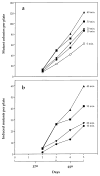Effect of endogenous carotenoids on "adaptive" mutation in Escherichia coli FC40
- PMID: 11166030
- PMCID: PMC2929247
- DOI: 10.1016/s0027-5107(00)00144-5
Effect of endogenous carotenoids on "adaptive" mutation in Escherichia coli FC40
Abstract
The appearance over many days of Lac(+) frameshift mutations in Escherichia coli strain FC40 incubated on lactose selection plates is a classic example of apparent "adaptive" mutation in an episomal gene. We show that endogenously overproduced carotenoids reduce adaptive mutation under selective conditions by a factor of around two. Carotenoids are known to scavenge singlet oxygen suggesting that the accumulation of oxidative base damage may be an integral part of the adaptive mutation phenomenon. If so, the lesion cannot be 7,8-dihydro-8-oxoguanine since adaptive mutation in FC40 is unaffected by mutM and mutY mutations. If active oxygen species such as singlet oxygen are involved in adaptive mutation then they should also induce frameshift mutations in FC40 under non-selective conditions. We show that such mutations can be induced under non-selective conditions by protoporphyrin photosensitisation and that this photodynamic induction is reduced by a factor of just over two when endogenous carotenoids are present. We argue that the involvement of oxidative damage would in no way be inconsistent with current understanding of the mechanism of adaptive mutation and the role of DNA polymerases.
Figures





References
MeSH terms
Substances
Grants and funding
LinkOut - more resources
Full Text Sources
Research Materials

